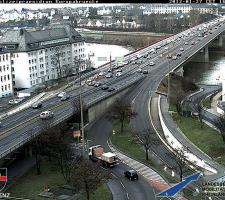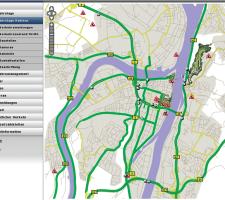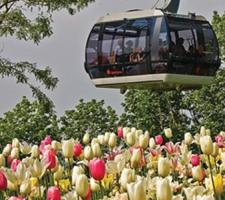
David Crawford reviews an award-winning scheme that delivered a 30% increase in website usage – below budget
The German Federal Agricultural Show (Bundesgartenschau, BUGA) runs between mid-April and mid-October every other year in a different city. The most recent, 2011, edition took place in Koblenz, a medium-sized community with a population of just over 105,000 in the Rheinland-Pfalz region, and was expected to draw an additional 40,000 visitors a day to its central area.Traffic access from the motorway links to Koblenz can be problematic, even under normal conditions, owing to the topography of the city, which lies at the confluence of the Rhine and Moselle rivers, with limited capacity on the connecting bridges. Coinciding events such as the August Rhein-in-Flammen (Rhine in Flames) firework display were going to accentuate the problem.
The chosen solution was to adapt the existing intermodal traffic information system (TIS) platform of the regional Rheinland-Pfalz Road Authority (LBM) to enable it to deliver consistent guidance extending over the urban area of Koblenz for the benefit of the additional visitors arriving by motorway.
First steps KOBLENZ TRAFFIC INFORMATION SYSTEM UPGRADE
Cost:
• €126,000 ($171,950)
Benefits:
• 37% saving on budget
• 30% rise in travel website usage
Project budget:
• €200,000 ($272,000)
Expenditure:
• New webcams €62,000 ($84,610)
• Data purchase and processing €39,000 ($53,223)
• Internal staff costs €25,000 ($34,117)
• Total €126,000 ($171,950)
Achieving this depended on the availability of comprehensive information on urban traffic conditions to enable the operation of strategically-located variable message signs and the inclusion of camera views of critical sections. The latter were intended for use both by the travelling public and in traffic control operations, as valuable feedback and ‘ground truth’ sources.
The resulting data would be added as a dedicated ‘BUGA’ layer to the portal.
(Public transport information came through an open web map service operated by the Koblenz Public Transport Association).
To gain the wider traffic condition information, the city decided as a first step to buy from German supplier
But this was not going to be enough to ensure the comprehensive coverage needed.
There was, in any case, a tightly-restricted project budget of €200,000 (US$272,000), of which the new cameras alone accounted for €62,000 (US$84,610). This ruled out a conventional solution involving a road-based monitoring system across the central area of Koblenz.
To fill the gap, the city contracted with US-headquartered private-sector traffic information provider
(The necessary location coding for this had already been carried out in 2009 and covered the area adequately, with the exception of one access road to a coach parking area).
Since the company already operated the mobility platform, there was no need for any further investment in the presentation of the Inrix data.
TraffGo Road also integrated data from the new traffic cameras and public transport information from the Koblenz PTA. This was the first example in the region of the public sector processing privately-sourced traffic data. The LBM’s Helga Rottenau told ITS International: “The project has raised interest in other German cities and similar projects have taken up elements of the approach. The concept of public authority purchasing of dynamic data from private content providers has recently been gaining in importance”.
It was a deliberate decision to offer drivers no routing guidance, since this could have come into conflict with advice being given by in-vehicle navigation systems or other sources. Instead, the approach was that drivers had ready access to an integrated, map-based format from which they could draw their own conclusions.
Project results
The project came in well under the budget and achieved a 30% increase in usage of the <%$Linker:
Reviewing it, the LBM’s Guido Schuster says: “Our traffic control centre, and that of the regional police, continuously observed the generated and disseminated level of service and webcam images and both have confirmed the high quality of the processed data”.
On transferability, he comments: “The buying-in of data is a concept that suits several business cases. It is faster than the planning for, and procurement, installation and testing of, new equipment; costs are lower over a short period; there is no maintenance requirement and no disruption caused by roadworks that could affect other events; and the data can also be used for additional purposes by a local administration, e.g. for calibrating traffic control applications”.
Following its success at BUGA – and despite earlier plans to mothball it in April 2012 – the major part of the service remains operational within the framework of a larger contract with the content provider. Only the coverage of the secondary urban roads has been reduced.
The project won the small-scale deployment category of the 2012
In other deployments, the LBM is currently using Inrix real-time data to display traffic state information for parts of its motorway and national roads network, which are not covered by stationary sensors.
The German region of Bavaria started to supplement its traffic information platform (<%$Linker:
The BUGA layer, using Inrix FV data, delivered content covering:
• Traffic situations
• Traffic messages
• Locations of construction sites in the city of Koblenz
• Locations of BUGA-dedicated park and ride sites
• Traffic webcam images from the LBM and Koblenz
• Locations of stations with link to current timetables
• Locations of bus stops with links to current timetables
• The layout of the BUGA site
EASYWAY PROGRAMME
The EC-supported EasyWay programme is an EU-wide, cross-border traffic management initiative set up to encourage ITS deployment on the major trans-European highways with the aim of reducing congestion, accidents and environmental impacts.
The only transport-sector platform to bring together the great majority of EU member states, it has now produced a set of common guidelines for ITS deployment to enable greater national and regional cooperation and interoperability.
It is also planning a future phase focusing on traffic management on longdistance road corridors.








